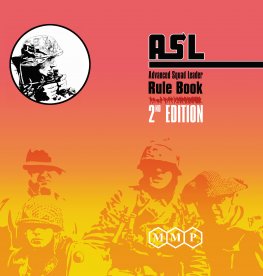
Hello again. I recently attended Bitter Ender in North Carolina and faced the same question three times over the course of the event: when does the +2 DRM apply to a Smoke Mortar? In particular, does it apply if it is the first thing my vehicle does in the Movement Phase? For a rule I think is pretty clear, it sure gets asked an awful lot. Why is that? Let’s look and see if we can figure it out.
Rules Dive

First, let me state this right up front. A vehicle which begins its MPh Stopped, and isn’t yet a Moving Vehicular Target, does not apply a +2 DRM to its Smoke Mortar. What follows explains the rules origin and how I conclude this.
Rule D13.32 states “A moving/Non-Stopped (C.8) AFV must add a +2 DRM to its sM Usage DR.” If you have read any of my previous articles on moving, moving vehicular target, Stopped, and Non-Stopped, you can probably already see the problem. The ASL Rule book does not define “Moving”. The ASOP loosely defines “moving” as the unit currently conducting its MPh. So in a sense, you can understand where the confusion comes from: this unit is “moving” so the +2 DRM applies.
Notice the reference to C.8. That rule defines what a “moving vehicular target” is. It is the rule resolving application of a Case J To Hit DRM. It also helps to define what “Non-Stopped” is so there is still some room to doubt that “moving” is enough to apply the +2 DRM.
History Of the Rule
The original version of the rule did not include a +2 DRM. It speaks only to Case A DRM and is silent on anything relative to “moving”. The +2 DRM first appears in the ‘89 replacement pages. The language remains largely the same today. Notably, the reference to C.8 is missing. Knowing this, we can dig into Q&A from that era to see what the rationale for the rule change is.


Period Q&A

The ASL Annual ‘96, page 38 offers this Q&A:
D13.32 Does the +2 DRM for firing the sM of a “moving/Motion AFV” apply to a Stopped vehicle that qualifies for being a Moving Target per C.8? To a Non-Stopped vehicle that is not a Moving Target?
A. Yes. No. [An96; Mw]
Given the timing of that Q&A and the subsequent update of the rule, it is safe to say the update is likely a response to the Q&A. While it might take some unpacking, the Q&A is clearly saying the +2 DRM only applies to AFV which is a “Moving Vehicular Target”. Notice how the +2 applies to a Stopped AFV that Case J applies to but does not apply to a Non-Stopped vehicle that Case J does not apply to. There is also an older Q&A that spells this out1D13.32 In line 10 does a “moving” AFV in this sentence refer to a Motion AFV? an AFV that is a moving target? or an AFV that is presently executing its MPh? A.Yes. Yes. Not necessarily. [Letter77].
Conclusion

This is a case where knowing the origins of the rule change is very helpful interpreting the rule. I don’t think this necessary though because I know the original rules used “moving” in several contexts. This is all spelled out in Ole Boe’s Stop and Go Traffic: Moving, Motion, and Non-Stopped Status article in the same ‘96 Annual. Subsequent rules changes have deprecated some of that article but I encourage you to read it if you get the chance. I summarized some of that article in this post.
Colophon
I am trying a new footnote plugin for this article. It is much more cumbersome than the one I usually use but this one seems to get the footnotes into the PDF downloads. I am going to try this out for a while to see how distracting it is. From a proofreading standpoint, it is a real pain to use since footnotes are in-line and handled by a style sheet to put them at the bottom of the article. You see them at the end of the article, as you should. I see them [footnote]inserted into the middle of the sentence where it will appear and I have to overlook the footnote when proofing.[/footnote] like this. We’ll see how it goes.
Have a good weekend everyone.
Footnotes:
- 1D13.32 In line 10 does a “moving” AFV in this sentence refer to a Motion AFV? an AFV that is a moving target? or an AFV that is presently executing its MPh? A.Yes. Yes. Not necessarily. [Letter77]


>>Notice how the +2 applies to a Stopped AFV that Case J applies to but does not apply to a Non-Stopped vehicle that Case J does not apply to.<<
How can you be Non-Stopped and NOT have Case J apply to you? Can someone give me a simple example?
Have a closer read of C.8. An AFV that starts its MPh Stopped and then spends one to Start, has not entered a new Location or hexside. As such, it is not yet a Moving Vehicular Target. If it begins its MPh in Motion, or has entered a new hex/hexside, IS a Moving Vehicular Target. — jim
Good article Jim. Another question coming from Bitter Ender is whether or not you have to pay an additional MP per ROF shot for an AFV using bounding fire. Also like to hear your thoughts on whether an ATR’s IFE firepower is doubled when adjacent or is it always only a 1 FP?
During your own MPh, the moving vehicle can only fire once per MP. This can be all the MGs and all the guns, but if something gets ROF and wishes to fire again, the AFV must spend another MP to do so. If the MA maintains ROF and NO OTHER weapon on the vehicle fires, the MA ONLY can fire again in AFPh.
The ATR’s IFE is doubled like any other IFE weapon. Why wouldn’t it be?
Jim is entirely correct, ATR is explicitly listed in A7.21 as a weapon which is doubled for PBF. I have come across this rules “interpretation” before however. I think it might stem from the footnote 8, which talks about the contribution of grenades being a basis for PBF effect. People read the footnote and then wonder why an ATR would be doubled, interestingly no one seems to ask the same of MGs.